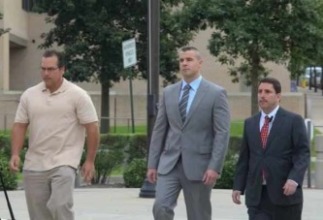Research Finds 'hierarchy of bias' (White Supremacy) Drives White Police Officer Decisions to Shoot Blacks & Latinos

In photo, Pleasantville Police Officer Aaron Hess who is presently accused of fatally shooting unarmed Black college student Danroy Henry [MORE] From [HERE] Both the police and student subjects were most likely to shoot at blacks, then Hispanics, then whites and finally, in a case of what might be called a positive bias, Asians, researchers found.
In the first study of its kind, Joshua Correll, Bernadette Park and Charles M. Judd of CU-Boulder's Department of Psychology and Neuroscience and Melody Sadler of San Diego State University examined how police and a group of undergraduate subjects decide whether to shoot or not to shoot "suspects" in a multi-ethnic environment.
"Most studies on the subject of stereotyping and prejudice look at two (ethnic) groups, usually in isolation. It's always one group against another group," said Correll, a CU graduate who joined the faculty in August after a stint at the University of Chicago. "But as the country becomes more ethnically diverse, it's more and more important to start thinking about how we process racial and ethnic cues in a multicultural environment," he said.
As with previous studies into the question, data were gathered from subjects playing a "first person shooter" video game, in which figures of varying ethnicity—Caucasian, Asian, Hispanic and African-American—pop up, either "armed" with a weapon or another benign object, such as a cell phone. Participants—69 CU-Boulder undergraduates and 254 police officers—had to make quick decisions as to which figures posed a "threat" and shoot them.
The police officers were recruited from two-day training seminars in Florida, New Mexico and Washington and represented numerous jurisdictions from 11 states. The research demonstrates how persistent cultural stereotypes are, Correll said. Even students who displayed little bias when interviewed demonstrated otherwise when faced with a split-second decision. "I may not believe it personally, but I am exposed to stereotypes constantly through media or social networks … (such as) the idea that young black men are dangerous," he said. "Those associations can have an influence on my behavior even if I don't believe them."
The study found that police were considerably more accurate than students at correctly identifying a genuinely threatening suspect, as opposed to those brandishing a cell phone or wallet, perhaps a reflection of training. But officers were still influenced by the target's race—an influence that may derive from the officers' "contacts, attitudes and stereotypes," Correll said.
For example, police who endorsed more violent stereotypes about Hispanics and those who overestimated the prevalence of violent crime in their districts demonstrated more bias to shoot Hispanic targets. That raises the question of whether police are responding to real-world threats—and whether that means some ethnic groups really are more likely to be armed and dangerous than others. "That is a very sensitive question, whether or not (police officers') reactions are based on some kind of truth. Is this police officers responding to reality on the ground? The short answer is, we don't know," Correll said. "But this research almost demands that we ask that question." The researchers' recent findings were published in the Journal of Social Issues.